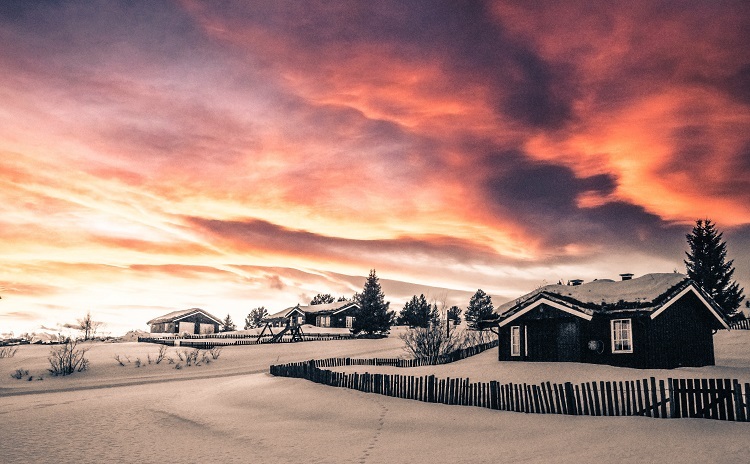Winter is the time when we love to stay indoors and keep ourselves warm and cozy. The problem is, the different things we use to keep us warm during winter generate more carbon emissions than in summer. Think of the gas and smoke emitted by our fireplaces, the energy wasted when our heating works overtime, and all the other appliances we use to keep ourselves warm and busy.
Eco-conscious homeowners are always searching for ways to reduce their carbon footprint no matter the season. Now that winter is almost here, know that there are ways you can keep up with your eco-friendly goals. But the question is, what can you do to reduce your carbon footprint while enjoying winter?
Table of Contents
Think About Your Fireplace
It feels so good to light up your fireplace and watch the crackling fire while trying to stay warm. There’s something comforting about knowing you can indoors and enjoy the warmth that fire has to offer during winter. But we need to remember that, in general, traditional fireplaces suck the air coming from your furnace and out of your living space.
This only means your furnace is working double-time to ensure enough fire keeping your space warm. The more you use your fireplace, the more overworked your furnace gets. One way to solve this dilemma is by investing in the proper wood inserts for your fireplace.
Fireplace inserts allow you to seal your fireplace. This, in turn, keeps the warm air inside. You get to save money by lowering your heating costs while reducing the amount of smoke coming out of your home.
With fireplace inserts, you no longer need to pay for unnecessary heating. This is since you are no longer going to heat every square inch of your home. This is how we make use of zone heating.
Zone heating reduces your thermostat while stimulating your fireplace insert. This enables you to only heat spaces where you want the heat to stay. You get to save energy and reduce the number of carbon emissions produced every time you use your fireplace.
Insulate the House Before Winter
Proper insulation is a safe way to ensure your heating system won’t need to work so hard to ensure comfort during the cold season. The problem is, many homeowners wait too long before insulating the house.
Many don’t even have a clue if their home requires additional insulation or not. If you are not sure, choose to do the right thing by improving home insulation. This way, your home stays well-insulated, and you won’t need to worry about wasting precious energy throughout winter.
For your attic, consider loose-fill insulation. This is the cheaper alternative to batt insulation. When installed the right way, you can enjoy better coverage at a cost-effective price.
Air seal knee walls and insulate rafters. Invest in floor and foundation insulation. Don’t forget about cathedral ceiling, duct, and exterior wall insulation.
Know that there are cheap ways to insulate the house if you lack the budget. Here are some ideas to try.
- Choose heavier curtains during the winter, preferably blackout curtains
- Plug your chimney using a chimney balloon
- Seal doorways using foam weatherstripping
- Reglaze doors and windows along with loose panes
- Fix drafty doors using a door snake
- Insulate water pipes using foam pipe sleeves
- Swap outdoor faucets with a frost-proof outdoor faucet
- Properly seal air leakage points found in light fixtures, outlets, and switches
- Use spray foam sealant for exterior holes like
- Cover room air conditioners
Invest in Heating, Ventilation, and Air Conditioning (HVAC) Maintenance
Many homeowners forget about maintaining their HVAC system. They wait until repair and maintenance are required before they keep up with their HVAC responsibilities. This, in turn, leads to existing issues being missed, which only increases their costs, wasted energy, and carbon emissions.
Make sure you stay up to date with your HVAC maintenance tasks. Replace the filters, keep your condensing unit clean, and call a certified technician to repair and maintain your system. This will help you lessen the amount of fossil fuel your system consumes and the carbon emissions that go straight to the environment.
Upgrade Old Systems
Today’s new home systems are considerably more energy-efficient than the ones in the market a decade ago. During winter, keeping worn-out heat pumps, furnaces, and other heating systems will only be a safety hazard. When repairs and maintenance no longer work, consider upgrading your old heating systems asap.
The newer your systems are, the more energy-efficient they tend to be. This allows you to increase your energy savings while helping reduce the amount of energy wasted after every use. You can even enjoy utility incentives for investing in newer heat pumps.
These are a few strategies for eco-conscious homeowners like you can stay warm without feeling guilty. Using these simple steps, you get to save energy, ensure your family’s comfort, and reduce your home’s carbon footprint. This shows that you can reduce your home’s carbon footprint with suitable projects even if the season is freezing cold.
Meta title: Winter’s Coming: Reducing Your Carbon Emissions at Home
meta desc: Eco-conscious homeowners search for ways to reduce their carbon footprint. Now that winter is almost here, know how to keep up with your eco-friendly goals.
